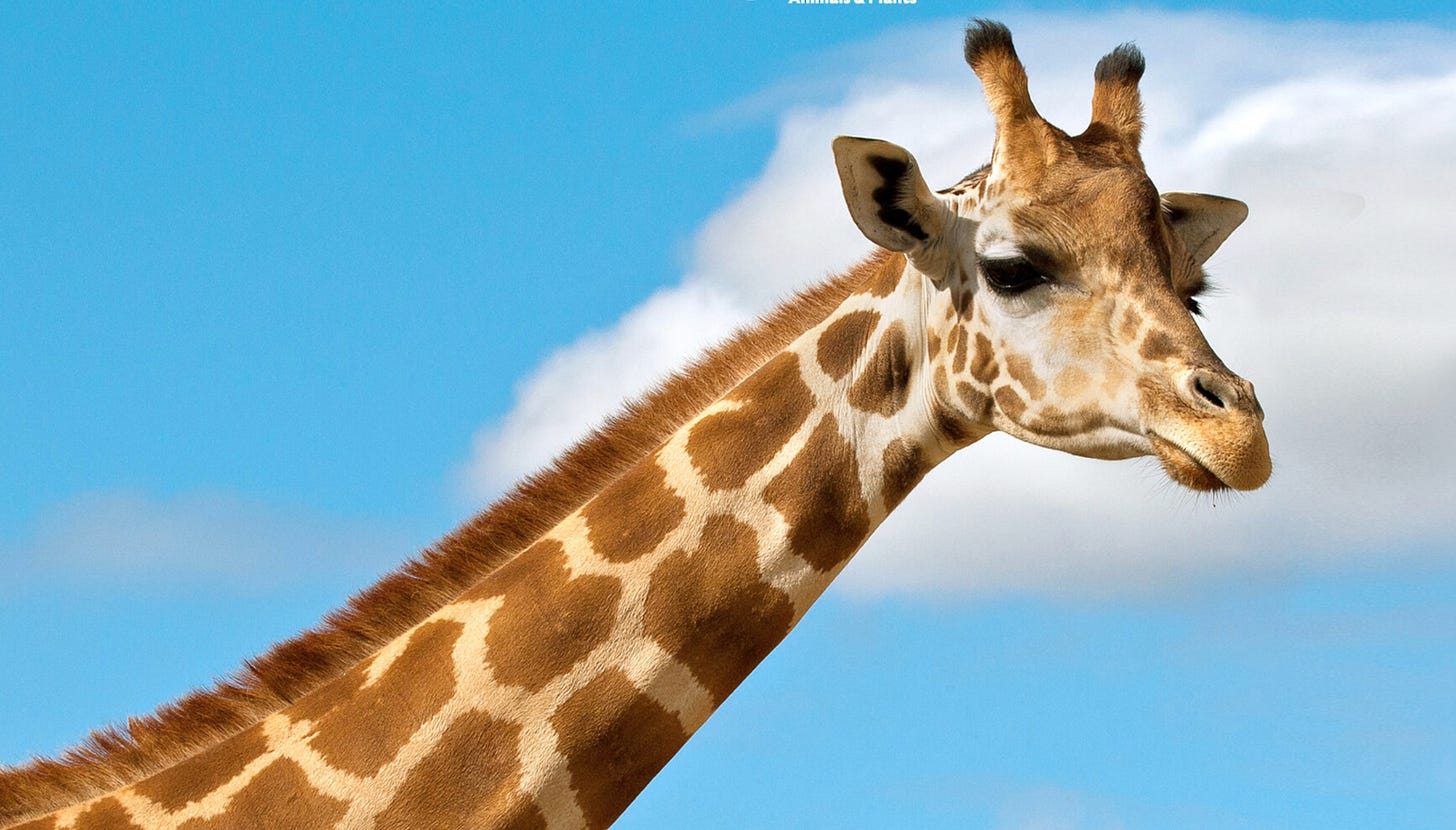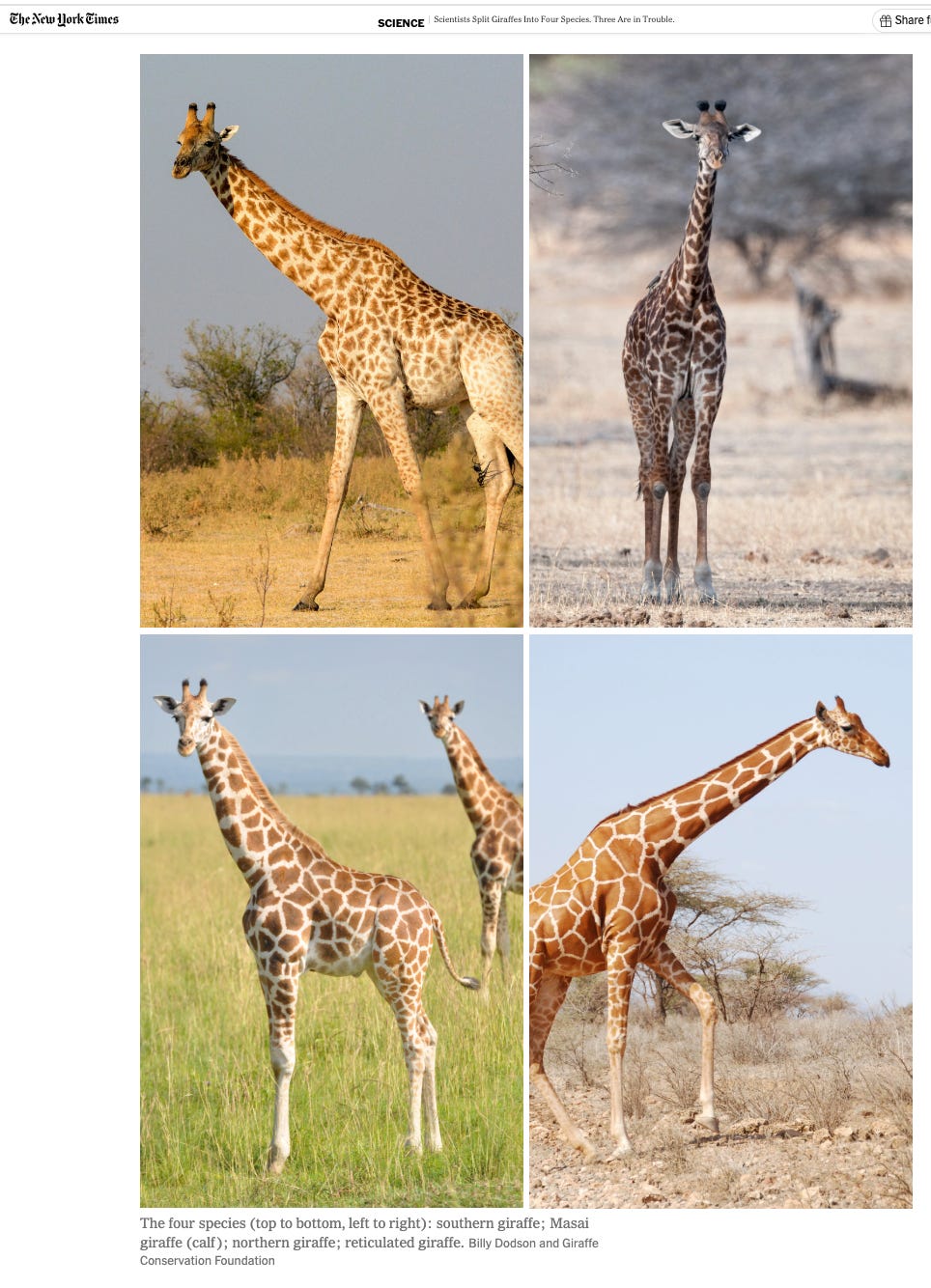Should Human Biodiversity Be as Respectable as Giraffe Biodiversity?
If I'm for studying giraffe biodiversity, why should I not be for studying human biodiversity?
The study of human biodiversity is of course closely related to the study of biodiversity in general.
Lots of people find learning about different types of living things to be interesting. Here in the United States, we’ve spent and/or foregone huge amounts of money to preserve biodiversity since the 1973 Endangered Species Act.
In general, that strikes me as a good thing.
On the other hand, the conventional wisdom is fanatically crazy about preserving non-human biodiversity while at the same time denying human biodiversity. For example, Wikipedia has been taken over by a clique of leftist nuts:
Scientific racism, sometimes termed biological racism, is the pseudoscientific belief that the human species is divided into biologically distinct taxa called "races",[1][2][3] and that empirical evidence exists to support or justify racial discrimination, racial inferiority, or racial superiority.[4][5][6][7] Before the mid-20th century, scientific racism was accepted throughout the scientific community, but it is no longer considered scientific.[5][6] The division of humankind into biologically separate groups, along with the assignment of particular physical and mental characteristics to these groups through constructing and applying corresponding explanatory models, is referred to as racialism, racial realism, race realism, or race science by those who support these ideas. Modern scientific consensus rejects this view as being irreconcilable with modern genetic research.[8]
Scientific racism misapplies, misconstrues, or distorts anthropology (notably physical anthropology), craniometry, evolutionary biology, and other disciplines or pseudo-disciplines through proposing anthropological typologies to classify human populations into physically discrete human races, some of which might be asserted to be superior or inferior to others.
In contrast, giraffes have recently been declared to not be one species, but four.
How scientific is that? Lots of scientists over the last quarter of a millennium thought we only needed one species to accommodate all giraffes, while other thought we should designate eight or nine species.
Recently, a institution compromised and announced there are officially now four giraffe species, although the following New York Times article doesn’t explain why those four groups would be species rather than geographic races.
Personally, I’ve been in favor of giraffes being preserved. But how much do I care about four different types of giraffes instead of giraffes in general?
Scientists Split Giraffes Into Four Species. Three Are in Trouble.
A reassessment of the iconic species has “some dramatic implications for how we view giraffe conservation across Africa,” a new study concludes.
By Carl Zimmer
Aug. 22, 2025
For more than 260 years, scientists have consider giraffes a single species. Giraffa camelopardalis, as it was long known, existed across thousands of miles of African grasslands and woodlands.
But scientists now see giraffes differently. One species is officially four, the International Union for Conservation of Nature announced on Thursday. Conservation biologists will now evaluate the status of each; preliminary data suggest three of the species are threatened with extinction.
“A giraffe is not a giraffe, so to speak,” said Michael Brown, an author of the assessment. “Now we have four different species, each with their own narrative. This has some dramatic implications for how we view giraffe conservation across Africa.”
It’s easy to tell giraffes apart from other mammals, thanks to their magnificently long necks. But other, subtle differences set giraffes apart from one another. By the 1800s, for instance, European zoologists who examined giraffe hides that were shipped to museums were noting distinctive patterns and colors among them.
Giraffes in different regions appeared to have distinctive coats, leading some researchers to argue that the species contained eight or nine subspecies — populations that could be distinguished from one another but could still interbreed. …
That drop led the I.U.C.N. to declare the species vulnerable in 2016. But that assessment assumed that all giraffes belong to a single species. And new evidence has raised questions about that assumption.
A 2024 study of DNA, for example, revealed that living giraffes belong to four main branches that do not interbreed much since diverging from a common ancestor about 280,000 years ago.
In 1491, when was the last time that Amerindians and sub-Saharans had interbred?
Another 2024 study, of 515 giraffe skulls, revealed anatomical differences between the four groups.
Calipers!
… Reviewing these and other studies, Dr. Brown and other giraffe experts agreed the animals belonged to four species, not one.
I dunno. They look pretty similar to me.
On the other hand, giraffes are pretty great in general.
The species with the biggest population is the southern giraffe, or Giraffa giraffa. It lives in South Africa and surrounding countries and, according to the Giraffe Conservation Foundation’s 2025 annual report, consists of 68,837 animals.
The other three species have much smaller ranges and populations. The Masai giraffe, Giraffa tippelskirchi, lives in eastern Africa. The reticulated giraffe, Giraffa reticulata, has a range extending farther north, in Kenya and southern Ethiopia. And the forth species, the northern giraffe, retains the original name for all giraffes, Giraffa camelopardalis. It survives in scattered pockets from South Sudan to Niger.
Rasmus Heller, a population geneticist at the University of Copenhagen who carried out the 2024 study on giraffe DNA, cautioned that drawing sharp lines between evolving populations can be tricky. “Nature doesn’t fit nicely into species,” said Dr. Heller, who was not involved in the new assessment.
He noted that the four proposed species have mixed their genes together from time to time, as giraffes from different populations encountered each other and mated. In fact, the reticulated giraffes are hybrids; their ancestry is about evenly split between northern giraffes and southern giraffes.
“Giraffes are a hard nut to crack,” he said. “You could reach the conclusion that there are different species, or you might not.” …
For his part, Dr. Bercovitch thinks the I.U.C.N. team did not go far enough. The data leads him to view almost all of the subspecies as distinct species; instead of four species, he would recognize eight. …
The northern giraffe, with only 7,037 animals, faces particularly big challenges to its survival. Its meager population is scattered in isolated pockets, many of which are in countries facing poverty and war.
Personally, I’m in favor of preserving giraffes.




Hilariously, it seems they mainly differ by skin pattern. Of course that's just me using my lying eyes but it would seem like there are other species which the calipers might differentiate more easily and on more spectra.
Commenting from NZ, I do find myself feeling some sympathy for the plight of the the northerner, with its smaller population and its greater challenges to survival. Having Its meager population scattered in isolated pockets.
And finally, in passing, one wonders if Hybrid-American will ever come into fashion (capitalized of course).
"each with their own narrative."
The giraffes remain silent.